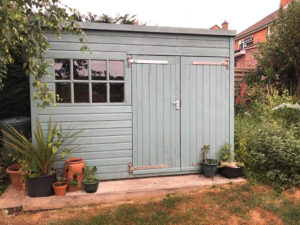 If you want to build a shed in your garden, then a concrete base is your most durable and sturdy option. This base provides you resistance to frost and moisture from the ground, thus preserving the material you used to build your shed and the tools you have stored inside. For a garden shed, you will need to build a concrete base that is slightly larger in every dimension than the shed. Moreover, it must also be a bit raised from the ground.
If you want to build a shed in your garden, then a concrete base is your most durable and sturdy option. This base provides you resistance to frost and moisture from the ground, thus preserving the material you used to build your shed and the tools you have stored inside. For a garden shed, you will need to build a concrete base that is slightly larger in every dimension than the shed. Moreover, it must also be a bit raised from the ground.
In this article, we provide you with a step-by-step guide to construct a concrete base for your garden shed, using a concrete mixer.
What Tools are Required for this Project
- Tape measure
- Hammer
- Saw
- 4 ft. Level
- Shovel
- Garden Rake
- Water Hose
- String
- Timber
- Screed board
- Reinforcing Bar and ties
- Gravel
- Concrete Mix
- Concrete Mixer
- Wheelbarrow, to transfer the soil you are going to dig out for the foundation
- PPE: Work gloves, dust mask, safety goggles and safety boots
Step 1: Choose the most Suitable Location for your Garden Shed
First of all, you need to pinpoint the exact location you will build your garden shed. You have to keep in mind that a concrete base is a permanent foundation and thus it is difficult to remove. It is very important to ensure before you start digging, that the location you have chosen is free from underground utility lines. When you are sure about that, you can go on and clear the spot from any trees and shrubs. Remember to also clear out 1.5m in every direction so that you have all the space you need.
Step 2: Dig out the Foundation
When you reach this step, you have already leveled the ground above and taken measurements. The next step is to draw the lines where the shed is going to be built, and then digging out the foundation for the concrete base. When you dig out the whole surface, place a line between two stakes and use your level to determine if the surface is smooth.
Your concrete base should be in total around 10cm, with the 2cm above the ground. Therefore, you will need to dig this area and some more, because you need extra space to set the form in place.
Step 3: Build the Form of your Concrete Base
Next, you can build your concrete form. In the market, there are kits for making the concrete form, even though you can easily do it with timber boards. Make sure that you have purchased some quality and straight timber. When taking measurements, keep in mind that the inside measurement is going to be the final result as the form is going to be removed once the concrete is cured.
Step 4: Spread the Gravel to Uniform the Foundation
Now that you have created the foundation, it’s time to fill it with gravel. This filling should be around 5cm high and well-uniformed. If the gravel is too dry, use the hose to mist it so that is sticks together. Level the gravel once again to make sure that it has the same depth in every part of the foundation.
Step 5: Install the Concrete Reinforcing Bar
Reinforcing bar, or rebar, is a steel bar used to enhance the tensile strength of the concrete base. Rebar also prevents concrete from cracking which is a common issue. For this step, you can use steel rebar, steel mesh, or add synthetic fiber to your concrete. No matter the material you use though, make sure to add rebar around the perimeter of your foundation. This way, you will help the concrete be stronger to support the walls of the garden shed.
Step 6: Mix and Pour the Concrete
When mixing the concrete, you should be aware that time is of the essence. Concrete starts to stiffen from the moment it is mixed and will be in a workable state for the following two hours. So, when you begin this process, make sure that you can have all the time needed.
To estimate the concrete you need for your base, multiply the length by the width. Then, take this number and multiply it with the desired thickness. However, make sure that you add about 10% more concrete, to make sure that you are covered in case something goes wrong.
For your concrete, you have two choices, either mix concrete and sand in a 1:5 ratio or use a pre-mixed concrete. Regardless of your choice, place the mix and the water in the concrete mixer. Once you have the correct consistency, pour the concrete from one corner, until it fills the formwork.
Step 7: Level the Surface with a Screed Board
At this point, the concrete should be slightly above the form you have created. Use a rake to spread it evenly in your base. Once this is done, use a screed board to smooth the concrete and fill the areas that don’t have the required concrete. Make 3 or 4 passes with the screed board so that the surface is smooth and even.
Step 8: Finish and Edge the Concrete Base
Let the concrete sit for a while and when the water from the surface has evaporated, the concrete is ready to finish. For this job, use a hand float and then a steel trowel. However, if you need a no-slip surface, you should skip the steel trowel.
Furthermore, at this point you can edge the concrete in the areas that it meets the forms. This helps reduce the chance of chipping.
Step 9: Help the Curing by Keeping the Base Moist
Now that your concrete base is in place, you should let it cure properly to have a longer lifespan. The best way to do that is to prevent the concrete from drying too quickly. For the next 5 to 7 days, make sure to mist the surface with your hose and cover the surface with a plastic cover. Raise this plastic cover so that it doesn’t touch the concrete and use some bricks to keep it in place.
Once the concrete base is set, you can remove the form with the help of a crowbar and install your garden shed.
After following all of the above steps, you have a durable foundation for your garden shed.

